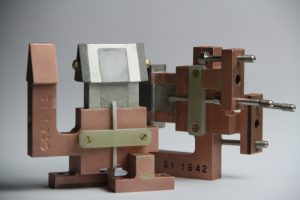What kind of coil would you use to harden your gear? Does size matter?
How can we choose the best size of our coil? What does the design of our inductor depend on? Gear size is the key point that answers these questions. To satisfy all the requirements necessary to harden the teeth of a gear with a narrow space, numerous challenges have to be faced such as the design of the inductor’s cooling system and the design of the showers to avoid self-tempering.
SAET state-of-the-art metallurgical laboratory, utilizing the most up to date technologies, and the coils design department have found a solution for small gears hardening.
As usual, the inductor must be simulated and designed to ensure the hardening specifications required, but in this case the constraints connected to the small geometry play in opposite directions: on the one hand, the flux concentrators and the conductor sections have to be optimized to keep the current flow as close as possible to the gear root; on the other hand, it is necessary to maximize the inductor internal cooling to avoid overheating and increase the inductor life. The design of the showers both for quenching and for side teeth cooling are challenging too: tight spaces and obstacles make the water path quite complex to design.

SAET has diverse solutions easy to adapt to the numerous issues that can arise with gears hardening, but the innovative 3D printing technology with the new inductor design and its simulations are essential for small gears hardening. SAET has invested heavily in developing a 3D printed coils technology. The acquired know-how allows the optimization of the design for both the active conductor geometry and the internal cooling system. This technology ensures to reach the required specs with a greater stability and a long-lasting inductor life. The alloy of silver and copper used by SAET for 3D printed coils is chosen to maximize the electrical efficiency of the inductor with results comparable with the ones achieved with classical manufacturing technologies, giving the possibility to manufacture more complex inductor designs.
The possibility to re-define the technological constraint in the inductors design using the new 3D printing technology, combined with the SW simulations tools, gave us a new way to reach better performance in terms of energy consumption and components life.